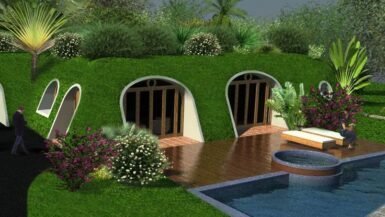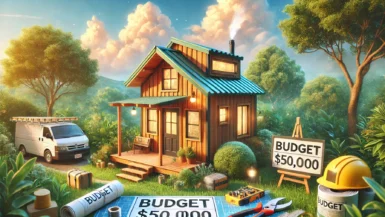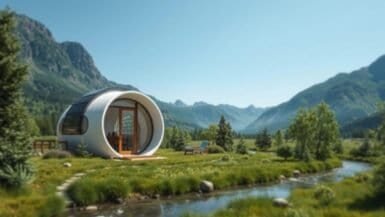In recent years, the concept of sustainable living has gained momentum, with more and more people opting for eco-friendly lifestyles. One such approach is dwelling in a tiny home, which not only reduces the carbon footprint but also promotes a minimalistic way of life. In this article, we delve into the essential principles of designing a sustainable tiny home for eco-friendly living. We will explore the vital aspects of location, materials, energy efficiency, and waste management, providing you with practical insights and guidance to create a harmonious, environmentally responsible living space. Join us as we embark on this journey towards a greener, more sustainable future.
Choosing Energy-Efficient Appliances for Your Tiny Home
Incorporating energy-efficient appliances is a key aspect of designing a sustainable tiny home. By selecting appliances that consume less energy, you can reduce your overall energy usage, lower your utility bills, and minimize your carbon footprint. In this section, we will discuss how to choose the most efficient appliances for your tiny home, with a focus on essential items such as refrigerators, cooking appliances, heating and cooling systems, and lighting.
Finding the Right Refrigerator
Refrigerators are one of the most energy-consuming appliances in any home. When shopping for a refrigerator for your tiny home, look for models with the ENERGY STAR label, which indicates that the appliance meets energy efficiency guidelines set by the U.S. Environmental Protection Agency. Additionally, consider choosing a smaller refrigerator with suitable storage capacity for your needs, making sure it has adequate insulation and an efficient compressor to save energy.
Efficient Cooking Appliances
Opt for cooking appliances that consume less energy and take up minimal space in your tiny home. Induction cooktops are a great option as they use magnetic fields to heat cookware directly, making them more energy-efficient than traditional electric or gas cooktops. Additionally, convection ovens and toaster ovens can be perfect for tiny homes, as they cook food faster and use less energy compared to conventional ovens.
Heating and Cooling Solutions
The heating and cooling system in your tiny home can significantly impact your energy consumption. Opt for a ductless mini-split system that provides both heating and cooling while consuming less energy than traditional HVAC systems. Alternatively, consider using a combination of energy-efficient space heaters and ceiling fans to maintain a comfortable temperature in your tiny home.
Energy-Saving Lighting Options
Lighting plays a crucial role in creating a cozy atmosphere in your tiny home, and choosing energy-efficient options can make a significant difference. Switch to LED bulbs, which consume up to 80% less energy than traditional incandescent bulbs and last much longer. Make the most of natural light by incorporating large windows and skylights in your tiny home design, reducing the need for artificial lighting during the day.
By carefully selecting energy-efficient appliances and incorporating smart design choices, you can create a sustainable tiny home that is both eco-friendly and comfortable.
Incorporating Solar Power Systems in Tiny House Designs
Embracing solar power is an excellent way to power your tiny home while reducing your environmental impact. By incorporating solar panels and other solar technologies in your tiny house design, you can harness the sun’s energy to generate electricity, heat water, and even provide passive heating or cooling. In this section, we will explore various solar power options available for tiny homes, along with practical tips on installation and maintenance.
Choosing the Right Solar Panels
Solar panels are the backbone of any solar power system, converting sunlight into electricity. When selecting solar panels for your tiny home, consider factors such as efficiency, size, and cost. Monocrystalline solar panels are known for their high efficiency, but they can be more expensive than polycrystalline panels, which offer a lower efficiency but are more budget-friendly. Also, consider the size of the solar panels, ensuring they will fit on your tiny home’s roof or another mounting location without compromising aesthetics or structural integrity.
Optimizing Solar Power Output
To maximize the efficiency of your solar power system, it’s essential to ensure your solar panels receive ample sunlight throughout the day. Install your solar panels on a south-facing roof or mount them on an adjustable ground system to capture maximum sunlight. Additionally, it’s crucial to regularly clean and maintain your solar panels, removing dirt, dust, and debris that may hinder their performance.
Solar Water Heating Systems
Solar water heating systems are a practical addition to any sustainable tiny home, using the sun’s energy to heat water for bathing, dishwashing, and other household needs. There are two main types of solar water heaters: active systems that use pumps to circulate water, and passive systems that rely on natural convection. Each has its advantages and drawbacks, so evaluate your specific needs and preferences when deciding which option is best for your tiny home.
Battery Storage and Backup Solutions
A critical component of any solar power system is the ability to store excess energy for later use. Installing a battery storage system in your tiny home allows you to store the electricity generated by your solar panels during the day, ensuring you have a reliable source of power when the sun isn’t shining. Additionally, consider incorporating a backup power source like a portable generator for those rare occasions when your solar power system may not provide sufficient energy.
By thoughtfully integrating solar power technologies into your tiny home design, you can create a sustainable living space that harnesses clean, renewable energy from the sun. This not only reduces your reliance on traditional energy sources but also contributes to a greener, more eco-friendly lifestyle.
Maximizing Natural Light and Ventilation in Small Spaces
Designing a sustainable tiny home goes beyond choosing energy-efficient appliances and incorporating renewable energy sources. A crucial aspect of eco-friendly living is taking advantage of natural light and ventilation to create a comfortable, healthy indoor environment. In this section, we will discuss how you can maximize natural light and ventilation in your tiny home, considering factors such as window placement, design features, and space planning.
Strategically Placing Windows and Skylights
Window placement plays a significant role in ensuring optimal natural light and ventilation in small spaces. Positioning windows on the south and north sides of your tiny home can help capture more sunlight throughout the day, reducing the need for artificial lighting. Skylights can be an excellent addition, as they not only bring in more sunlight but also provide a sense of spaciousness in compact areas. Additionally, installing operable windows can help improve cross-ventilation, allowing fresh air to circulate and maintaining a comfortable indoor temperature.
Opting for Light-Enhancing Design Features
Certain design features can help enhance the natural light that enters your tiny home. For instance, using light-colored wall finishes, flooring, and furnishings can reflect sunlight and make the space appear brighter and more open. Mirrors can also be strategically placed to reflect and distribute light throughout the interior, giving the illusion of a larger space. Moreover, incorporating transparent or translucent elements, such as glass doors and partitions, can allow light to pass through while maintaining privacy.
Creating an Open and Airy Floor Plan
An open and well-planned floor layout can go a long way in ensuring proper natural light and ventilation in your tiny home. Eliminate unnecessary walls and partitions to create a more open space that allows light and air to flow freely. Additionally, consider designing a loft-style bedroom or using a Murphy bed that can be folded up during the day, freeing up valuable floor space and promoting better airflow.
Incorporating Greenery and Outdoor Living Spaces
Integrating greenery and outdoor living spaces can significantly improve the natural light and ventilation in your tiny home. Indoor plants not only enhance the aesthetics of your living space but also improve air quality by filtering pollutants and producing oxygen. Creating outdoor living spaces, such as patios or rooftop gardens, can provide additional areas for relaxation and entertainment while connecting you with nature, further promoting a sustainable lifestyle.
By paying close attention to these aspects of natural light and ventilation, you can create a sustainable tiny home that not only reduces energy consumption but also provides a healthier, more enjoyable living environment.
Sustainable Materials and Insulation Techniques for Tiny Homes
Creating an eco-friendly tiny home involves more than just incorporating energy-efficient appliances and renewable energy sources. The materials used in the construction and insulation of your tiny home play an equally vital role in ensuring its sustainability. In this section, we will explore various sustainable building materials and insulation techniques that can help you build an environmentally responsible tiny home while enhancing its durability, energy efficiency, and overall comfort.
Environmentally Friendly Building Materials
When selecting building materials for your tiny home, opt for those that have a low environmental impact and promote a healthy indoor environment. Some sustainable building materials to consider include:
1. Reclaimed or recycled materials: Reusing materials from old structures or using recycled materials, such as reclaimed wood or recycled metal, can significantly reduce the environmental impact of your tiny home’s construction while adding character and charm to your space.
2. Sustainable wood: Choose responsibly sourced, sustainably harvested wood from certified forests to ensure that your tiny home’s construction doesn’t contribute to deforestation.
3. Sustainable insulation: Opt for eco-friendly insulation materials, such as cellulose, sheep’s wool, or cork, which have a lower environmental impact compared to traditional insulation materials like fiberglass.
4. Non-toxic finishes: Use low or zero-VOC (volatile organic compound) paints, adhesives, and sealants to minimize indoor air pollution and create a healthier living environment.
Optimizing Insulation for Energy Efficiency
Proper insulation is crucial for maintaining a comfortable temperature in your tiny home and reducing energy consumption. Consider the following insulation techniques to enhance your tiny home’s energy efficiency:
1. Comprehensive insulation: Ensure that your tiny home is well-insulated in all areas, including walls, roof, and floor, to minimize heat loss during winter and heat gain during summer.
2. High R-value materials: Choose insulation materials with a high R-value (a measure of thermal resistance), which provide better insulation and reduce energy consumption.
3. Proper installation: Ensure that your insulation is installed correctly, with no gaps or air leaks, to maximize its effectiveness and prevent drafts.
4. Continuous insulation: Implement a continuous insulation system that covers the entire building envelope, including the framing, to minimize thermal bridging and enhance energy efficiency.
Passive Design Strategies for Tiny Homes
Incorporating passive design strategies can significantly improve your tiny home’s energy efficiency by harnessing natural resources to maintain a comfortable indoor temperature. Some passive design techniques to consider include:
1. Solar orientation: Position your tiny home to take advantage of the sun’s path, with south-facing windows for maximum solar gain during winter and sufficient shading during summer.
2. Thermal mass: Incorporate materials with high thermal mass, such as stone or concrete, in your tiny home’s construction to store and release heat, helping to maintain a stable indoor temperature.
3. Natural ventilation: Design your tiny home to promote cross-ventilation through strategically placed windows and vents, allowing fresh air to circulate and reduce the need for mechanical cooling.
By carefully selecting sustainable building materials and implementing efficient insulation techniques, you can create a tiny home that not only minimizes its environmental impact but also offers a comfortable, energy-efficient living space for you and your family.
Water Conservation Strategies for Eco-Friendly Tiny Living
An essential aspect of designing a sustainable tiny home is implementing water conservation strategies to minimize water usage and reduce your overall environmental impact. In this section, we will discuss various effective methods for conserving water in your tiny home, ranging from efficient plumbing fixtures to innovative water management systems. These techniques will not only help you create a more eco-friendly living space but also contribute to the global effort to preserve our planet’s precious water resources.
Installing Water-Saving Plumbing Fixtures
Equipping your tiny home with water-saving plumbing fixtures can significantly reduce your water consumption without sacrificing comfort. Some fixtures to consider include:
1. Low-flow faucets: These faucets use aerators to mix air with water, reducing the flow rate while maintaining water pressure, resulting in water savings of up to 60%.
2. Dual-flush toilets: These toilets provide two flushing options – a full flush for solid waste and a partial flush for liquid waste, allowing you to save water according to your needs.
3. Water-efficient showerheads: Like low-flow faucets, water-efficient showerheads use aeration technology to maintain water pressure while using less water, resulting in savings of up to 40%.
Implementing a Greywater Recycling System
A greywater recycling system collects and treats water from sinks, showers, and washing machines, allowing you to reuse it for non-potable purposes such as toilet flushing, irrigation, and cleaning. By recycling greywater, you can significantly reduce your overall water consumption and lessen your impact on the environment. When designing a greywater system for your tiny home, consider factors such as treatment methods, storage capacity, and local regulations.
Harvesting Rainwater for Sustainable Water Supply
Rainwater harvesting is an excellent way to supplement your water supply while reducing your reliance on municipal sources. By collecting and storing rainwater from your tiny home’s roof, you can utilize this precious resource for various non-potable uses, such as irrigation, toilet flushing, and cleaning. Designing an effective rainwater harvesting system involves selecting suitable collection and storage methods, as well as considering factors like roof size, local rainfall patterns, and water demand.
Adopting Water-Smart Landscaping Techniques
If your tiny home has outdoor spaces, adopting water-smart landscaping techniques can further enhance your water conservation efforts. Some strategies to consider include:
1. Planting native or drought-tolerant plants that require minimal watering.
2. Using mulch to retain soil moisture and reduce evaporation.
3. Incorporating drip irrigation systems, which deliver water directly to plant roots, minimizing water waste.
By combining these water conservation strategies, you can create a sustainable tiny home that not only reduces its environmental impact but also promotes responsible water usage. This, in turn, contributes to the global effort to preserve our planet’s valuable water resources for future generations.





Leave a reply